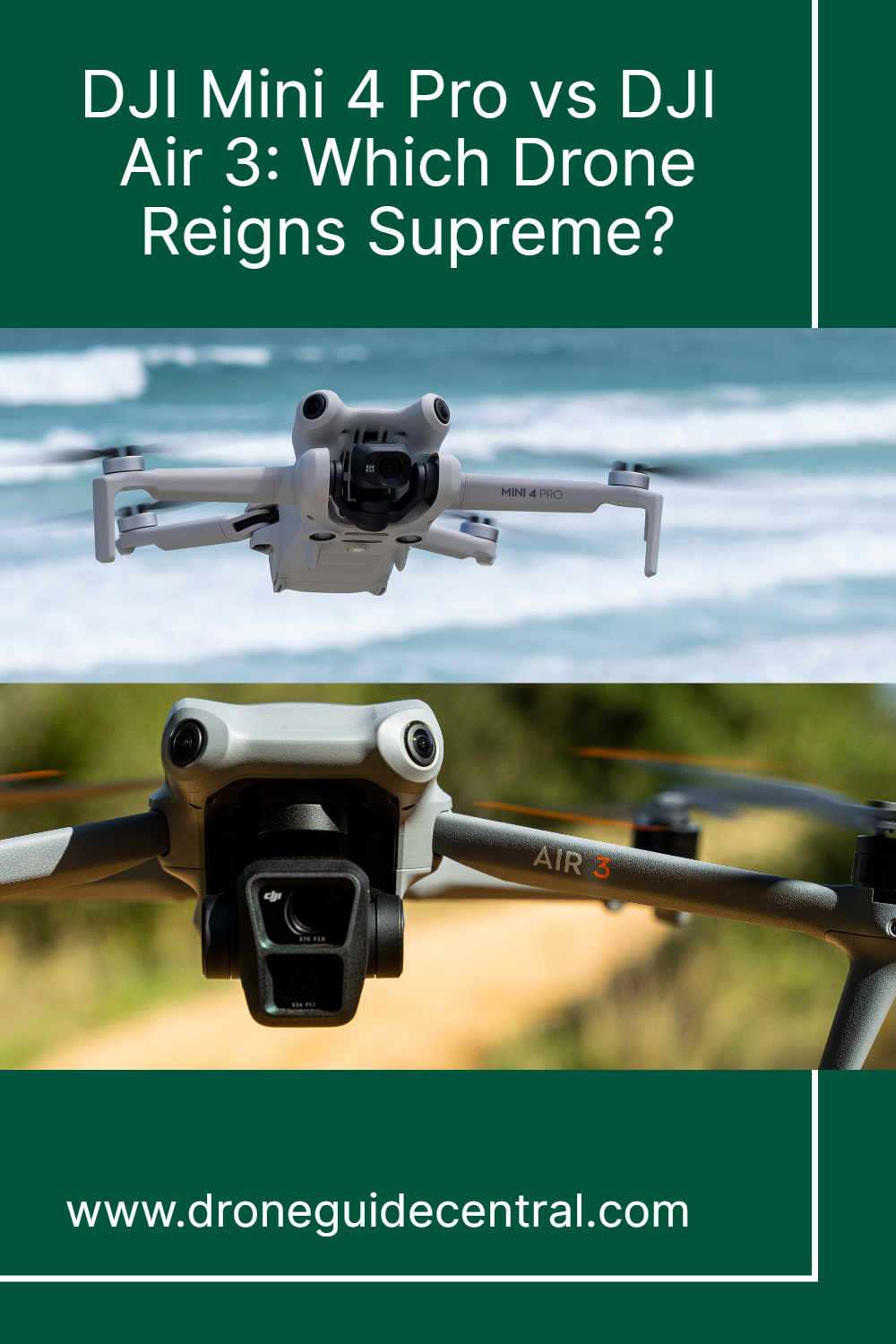
DJI Mini 4 Pro vs DJI Air 3: Which Drone Reigns Supreme?
DJI Mini 4 Pro and DJI Air 3 stand as titans in the realm of drones, offering a plethora of features designed to enhance aerial photography and videography. In this comprehensive comparison between DJI Mini 4 Pro vs DJI Air 3, we'll delve into their respective strengths and capabilities to assist you in selecting the perfect drone for your requirements.
Weight and Dimensions of DJI Mini 4 Pro vs DJI Air 3
Mini 4 Pro: Weighing under 0.54 lbs (249 grams) and measuring 5.827 × 3.701 × 2.520 inches (148 × 94 × 64 mm) when folded, the Mini 4 Pro is incredibly lightweight and compact, making it easy to carry in a pocket or small bag for spontaneous flights.
Air 3: With a weight of 25.39 oz (720 grams) and dimensions of 8.15 × 3.96 × 3.59 inches (207 × 100.5 × 91.1 mm), the Air 3 is larger and heavier than the Mini 4 Pro, offering stability and durability but requiring more space for transportation and storage.
Maximum Flight Performance
Mini 4 Pro: The Mini 4 Pro boasts a maximum flight time of 34 minutes and a wind speed resistance of 23.9 mph (10.7 m/s), providing reliable performance for aerial photography and videography in various weather conditions.
Air 3: Offering an impressive flight time of 46 minutes and a wind speed resistance of 26.84 mph (12 m/s), the Air 3 excels in extended flight missions and challenging environments, making it suitable for professional applications.
Camera Capabilities of DJI Mini 4 Pro vs. DJI Air 3
Mini 4 Pro: Equipped with a 48 MP camera featuring an FOV of 82.1° and an aperture of f/1.7, the Mini 4 Pro delivers high-resolution imagery with vibrant colors and sharp details. It also offers digital zoom capabilities of up to 3x for versatile framing options.
Air 3: The Air 3 features dual cameras, both with 48 MP resolution, offering wide-angle and medium telephoto options for diverse shooting scenarios. With an FOV of 82° and 35° and an aperture of f/2.8, it provides flexibility in capturing different perspectives, along with digital zoom capabilities of up to 9x for detailed close-ups.
Video Resolution and Transmission
Mini 4 Pro: Capable of recording in 4K at 100fps, and FHD at 100fps and 200fps, the Mini 4 Pro delivers smooth and high-quality video footage. It offers live view quality of up to 1080p at 60fps for real-time monitoring and control.
Air 3: The Air 3 records in 4K at 100fps, and goes further by offering 2.7K at 60fps ensuring cinematic video quality. It also provides live view quality of up to 1080p at 60fps for precise framing and composition during flight.
Advanced Features of DJI Mini 4 Pro vs DJI Air 3
Mini 4 Pro: A true vertical shooting and active track 360 degrees, enhancing creative possibilities and enabling dynamic subject tracking during flight. An omnidirectional sensing system adds another level of protection during flights.
Air 3: The vertical shooting crops the image for your convience and easy sharing on social media, while the omnidirectional sensing system ensures safe flight in challenging environments. It also offers advanced lossless optical zoom capabilities of up to 3x for detailed close-ups.
Transmission Range
Both drones offer impressive transmission ranges of up to 12.4 miles/20 km (FCC), and 6.2 miles/10 km everywhere else, allowing for long-range exploration and reliable communication between the drone and the remote controller.
Internal Storage
Mini 4 Pro: With 2 GB of internal storage, the Mini 4 Pro provides limited onboard storage capacity for storing photos and videos directly on the drone.
Air 3: Featuring 8 GB of internal storage, the Air 3 offers ample space for storing large volumes of media files, providing added convenience for users during flight missions.
Color Modes and Sampling
Both drones offer high dynamic range color modes both in Normal (8-bit 4:2:0 (H.264/H.265)), and HLG/D-Log M (10-bit 4:2:0 (H.265)), allowing for enhanced color grading and post-processing capabilities to achieve the desired cinematic look.
Antenna System
Mini 4 Pro: Equipped with the O4 transmission system, the Mini 4 Pro ensures stable and reliable communication with its four antennas and 2T4R technology between the drone and the remote controller, even in challenging RF environments
Air 3: Featuring six antennas and 2T4R technology, the Air 3's advanced antenna system enhances signal strength and stability, providing robust connectivity and control during flight missions.
User Experience and Ease of Use
Both drones prioritize user experience, with intuitive controls and accessible features suitable for pilots of all skill levels. Whether you're a novice exploring your first flight or an experienced flyer pushing the boundaries of aerial creativity, both drones offer a seamless and enjoyable experience.
Portability and Transportation of DJI Mini 4 Pro vs DJI Air 3
Mini 4 Pro: Renowned for its compact and foldable design, the Mini 4 Pro is highly portable and convenient for transportation. Its lightweight construction allows users to carry it in a small bag or even a pocket, making it perfect for travel, outdoor adventures, and on-the-go photography and videography.
Air 3: While the Air 3 is larger and heavier than the Mini 4 Pro, it still offers reasonable portability and transportation options. Users may opt for dedicated carrying cases or backpacks to transport the drone safely and securely, ensuring protection during travel and storage. Despite its larger size, the Air 3 remains a viable choice for users seeking versatility and performance in a portable package.
Flight Performance and Maneuverability
Mini 4 Pro: The Mini 4 Pro excels in agile and responsive flight performance, allowing users to navigate tight spaces and execute precise maneuvers with ease. Its compact size and lightweight construction contribute to its nimble handling, making it suitable for capturing dynamic aerial shots in diverse environments.
Air 3: With stable flight characteristics and precise control, the Air 3 offers reliable performance and maneuverability in various conditions. Its larger size and robust construction provide stability and resilience against wind gusts, enabling smooth flights and steady footage capture, even in challenging weather conditions.
Who Is DJI Mini 4 Pro For:
Enthusiasts seeking portability and advanced camera capabilities for on-the-go photography and videography.
Ideal for travel, outdoor adventures, and recreational flying, offering compact size and agile performance.
Generally more affordable, making it an attractive option for budget-conscious consumers.
Who Is DJI Air 3 For:
Professionals and content creators require extended flight time, dual-camera versatility, and advanced transmission features for professional-grade aerial content.
Suited for professional applications such as filmmaking, aerial surveying, and inspection tasks, providing extended flight time and advanced camera features.
A higher price point reflects advanced features and professional-grade capabilities, suitable for users with specific requirements.
Conclusion: Choosing Your Perfect Drone
In conclusion, the decision between DJI Mini 4 Pro and DJI Air 3 ultimately comes down to your specific needs, preferences, and intended use cases. Whether you prioritize portability, advanced camera capabilities, extended flight time, or user-friendly features, both drones offer exceptional performance and innovation in the realm of aerial photography and videography. By carefully considering factors such as weight and dimensions, camera features, flight performance, and support infrastructure, you can confidently select the perfect drone to elevate your aerial adventures and capture breathtaking moments from new perspectives.
FAQs About DJI Mini 4 Pro vs DJI Air 3:
Q: What are the main differences between the DJI Mini 4 Pro and DJI Air 3?
A: The DJI Mini 4 Pro is smaller and lighter, designed for portability and recreational use, while the DJI Air 3 offers extended flight time, dual-camera capabilities, and advanced features suited for professional applications.
Q: Which drone is more suitable for travel and outdoor adventures?
A: The DJI Mini 4 Pro is ideal for travel and outdoor adventures due to its compact size, lightweight design, and agility in tight spaces, making it effortless to pack and transport for spontaneous flights.
Q: What camera features do the DJI Mini 4 Pro and DJI Air 3 offer?
A: Both drones feature high-resolution cameras, with the Mini 4 Pro boasting a 48 MP wide-angle camera and the Air 3 offering a dual-camera system with wide-angle and medium telephoto options, providing versatility for different photography and videography needs.
Q: How do the flight times of the DJI Mini 4 Pro and DJI Air 3 compare?
A: The DJI Mini 4 Pro offers a flight time of up to 34 minutes, while the DJI Air 3 boasts an impressive flight time of up to 46 minutes, making it suitable for longer aerial sessions and professional applications requiring extended endurance.
Q: Can DJI Air 3 be used for professional filmmaking?
A: Yes, DJI Air 3 is suitable for professional filmmaking, thanks to its high-resolution dual-camera system, advanced stabilization, and support for professional color modes such as HLG/D-Log M. It provides filmmakers with versatile tools to capture cinematic footage with ease.

Copyright © Drone Guide Central - All Rights Reserved 2024

